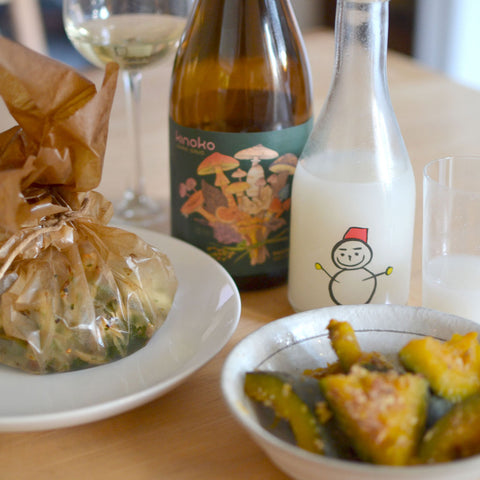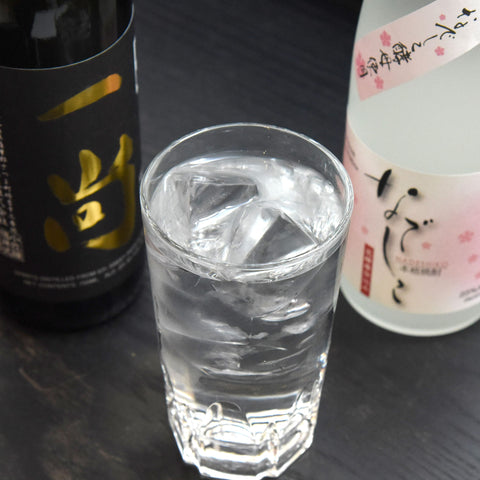
Making koji at Nishi Shuzo
Sake Gumi is our monthly sake subscription service with 200 members throughout the country. Join today!
Koji is a mold used to make sake, shochu, soy sauce, mirin, and miso. There are three main types of koji used in Japan – yellow, white, and black. For sake-making, the most common koji used is yellow koji (aspergillus oryzae). The two other types of koji are white (aspergillus kawachii) and black (aspergillus awamori), commonly used for shochu and awamori. All of the sakes for this month's bottles use yellow koji.
Yellow koji breaks down the rice starch into enzymes for saccharification (the process of making glucose). Then, the added yeast is able to ferment the glucose into alcohol. The use of koji is what sets sake apart from other fermented beverages. For example, if you make a rice beverage with just yeast and water, you would have rice beer. With the addition of koji, you have sake.
When asking different brewers about koji, their demeanor always softens, as though they are talking about their child. To brewers, koji is a living, breathing organism with unique characteristics that define the essence of their sake. While yeast has an influence on the aroma of sake, koji impacts the core flavor of the sake. So much so that all brewers consider koji-making to be the most important part of sake-making. Sasaki-san of Akita Brewery also makes this point, "The umami of koji creates a umami that is more suitable for pairing with food than other alcoholic beverages." In fact, all of the brewers heavily emphasize how beverages using koji beg to be paired with food due to their sweetness and acidity.
Every brewer has their own way of handling koji. The main difference I've seen is handmade versus machine-made, with brewers applying handmade koji to their finest – usually to their ginjos and daiginjos. I also often see brewers playing with how long they cultivate koji and at what temperature. Some brewers, including Hakkaisan, use the handmade technique for all of their sakes: "Koji for all of our sake – from our entry-level seishu up to ultra-premium daiginjo grades – are created by hand," says Tim Sullivan of Hakkaisan. "One major difference at Hakkaisan is that our overall production process for koji run up to 55 hours. Usual timing for koji is 48 hours. This extra time allows us to nurture the koji spores and have exacting control of the temperature."
This month, I've chosen a few sakes that exhibit the power of koji. For Level Two, there's the X3 Amairo Junmai Genshu, which uses three times the amount of koji than regular sake production, while the Hakkaisan Kijoshu in Level One uses sake, instead of water, during the last part of the moromi phase, emphasizing the umami and sweetness of the koji in the final brew. Enjoy the Koji Chronicles!
Kanpai
Yoko
Co-Founder + Sake Director
+++
 Tenbu Junmai
Tenbu Junmai
Nishi Shuzo (Kagoshima, Japan)
Seimaibuai: Akihonami 60%, SMV: N/A, Acidity: N/A
 Nishi Shuzo in Kagoshima Prefecture
Nishi Shuzo in Kagoshima Prefecture Hakkaisan Kijoshu
Hakkaisan Kijoshu
 Kawatsuru Olive Junmai Ginjo
Kawatsuru Olive Junmai Ginjo
Kawatsuru Brewery (Kagawa, Japan)
Seimaibuai: Sanuki Yoimai 58%, SMV: -7, Acidity: 2.0
 Kawatsuru Brewery in Kagawa Prefecture
Kawatsuru Brewery in Kagawa Prefecture X3 Amairo Junmai Genshu Sake
X3 Amairo Junmai Genshu Sake
Kinmon Akita Sake Brewery (Akita, Japan)
Seimaibuai: Menkoina 70%, SMV: -24, Acidity: 2.5



Comments (0)
There are no comments for this article. Be the first one to leave a message!